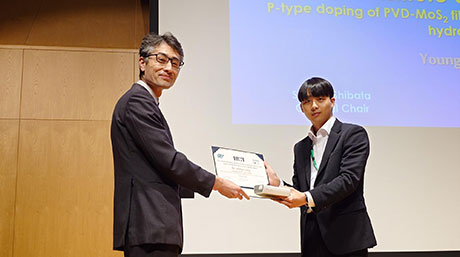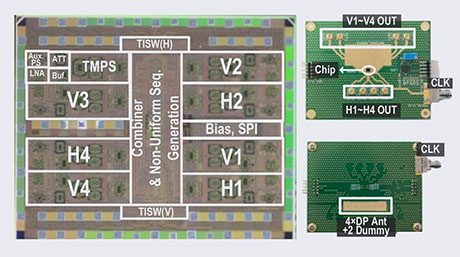Electrical and Electronic Engineering News
Development of a Ferroelectric Dimeric Liquid Crystal with Huge Spontaneous Polarization and Dielectric Constant at Low Temperatures
Contributing to improved performance of electronic devices
- Succeeded in developing a ferroelectric dimeric liquid crystal with huge spontaneous polarization (8 μCcm-2) and dielectric constant (8,000) at low temperatures (55℃ and higher)
- Achieved huge spontaneous polarization and dielectric constant by using three polar phases (nematic phase, smectic-A phase, and isotropic phase)
- Contributed to improved performance by applying dimer molecules to electronic devices such as capacitors, piezoelectric elements, electrostatic actuators, and 3D video display elements
At the Tokyo Tech LG Material & Life Solution Collaborative Research Cluster, a joint research team composed of Shigemasa Nakasugi (Joint Researcher with Industry and Other Organizations Including the Private Sector), Adj. Prof. Hiroki Ishizaki, Adj. Assoc. Prof. Sung Min Kang of LG Japan Lab, Prof. Masato Sone, Adj. Prof. Junji Watanabe and Assoc. Prof. Tso-Fu Mark Chang of the Laboratory for Future Interdisciplinary Research of Science and Technology, and Professor Takaaki Manaka of the School of Engineering, developed a ferroelectric dimeric liquid crystal with spontaneous polarization[1] that exceeds (8 μCcm-2) and a dielectric constant that exceeds 8,000 at low temperatures.
Ferroelectric liquid crystal[2] are a unique type of liquid crystal that have high spontaneous polarization and dielectric constant[3]. Among these, dimeric molecules have a simple molecular structure and can form a ferroelectric phase at low temperatures, so they are expected to be a material with excellent applications. In this research, the joint researchers developed a dimeric molecule called di-5 (3FM-C4T), which has a fluorine-substituted mesogen core linked to side wings by a pentamethylene spacer. Researchers confirmed that this dimeric molecule exhibits liquid crystallinity at low temperatures (55℃ to 211℃), and is composed of three polar phases: nematic, smectic, and isotropic, with a huge spontaneous polarization (8 μCcm-2) and dielectric constant (8,000). The researchers succeeded in developing a dimeric liquid crystal that exhibits ferroelectricity at low temperatures. Using the dimeric molecules developed through this research will enable the creation of technology such as capacitors for smaller electronic devices and lower power consumption, piezoelectric elements and electrostatic actuators that can be driven at low voltages, and holographic displays that show three-dimensional videos. This development is expected to lead to new applications in fields such as automobiles, industrial robots, and medical equipment.
These research results were achieved by the Tokyo Tech LG Material & Life Solution Collaborative Research Cluster, which is a joint research organization of LG Japan Lab and Tokyo Institute of Technology. The results were published in The Journal of Physical Chemistry B![]() .
.
Introduction
The ferroelectric liquid crystals are expected to have innovative applications in electronic devices because they exhibit higher spontaneous polarization and dielectric constant than conventional liquid crystals. Furthermore, because of their high-speed switching properties and memory effect, they have recently attracted attention as a favorable material for realizing holographic displays that require fine pixel structures.
The ferroelectricity requires a reduction of molecular symmetry and the chiral smectic-C phases with chiral molecules[4], the nematic phases with the specific functional groups, and the bent-shaped molecules with a bent structure have been developed so far. In particular, the bent-shaped molecules have the property that the bent structure of the molecule lowers the intramolecular symmetry, and the ferroelectricity can be expressed with a simple molecular structure that does not require the introduction of the specific functional groups. In addition, some bent-shaped molecules are known as dimeric molecules. While most bent-shaped molecules have mesogen[5] linked to the 1,3 positions of the aromatic core, the dimeric molecules contain a flexible alkylene group (odd-carbon number) as the mesogen linkage. This flexible alkylene group enables the dimeric molecule to form the ferroelectric phases at lower temperatures than conventional bent-shaped molecules, which is superior in terms of application development (refs. 1-3).
In this study, the research team focused on the dimeric molecules to develop new materials with huge spontaneous polarization and dielectric constant.
Research Results
In this study, the researchers developed a novel dimeric molecule with a large dipole moment[6] to achieve huge spontaneous polarization and dielectric constant. Specifically, they synthesized a dimeric molecule, di-5 (3FM-C4T), which has a fluorine-substituted mesogen core linked by pentamethylene spacers as side wings (Figure 1). Due to effective fluorine substitution, the mesogen core of di-5 (3FM-C4T) was found to have a very large dipole moment of 11.2 D by density functional theory. Di-5 (3FM-C4T) was structurally analyzed to reveal a ferroelectric nematic (NF), ferroelectric smectic-A (SmAPF), and polar isotropic (IsoP) phases (Figure 1).
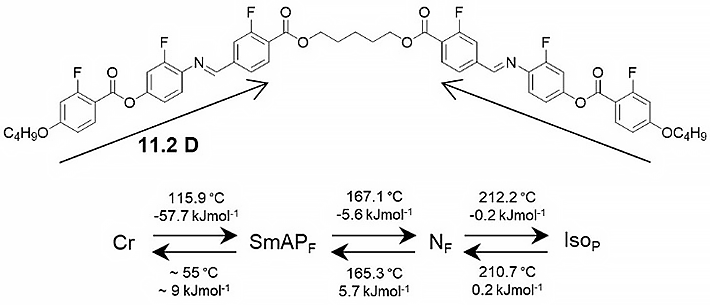
- Figure 1.
-
Molecular structure and phase sequence of di-5 (3FM-C4T). The transition temperatures and enthalpy changes are taken from the DSC 2nd heating and 1st cooling runs. The dipole moment value along the long axis of the one-side mesogen is calculated by density functional theory. The arrows represent the direction of the dipole moment.
- Figure 1.
-
Molecular structure and phase sequence of di-5 (3FM-C4T). The transition temperatures and enthalpy changes are taken from the DSC 2nd heating and 1st cooling runs. The dipole moment value along the long axis of the one-side mesogen is calculated by density functional theory. The arrows represent the direction of the dipole moment.
As shown in Figure 2 (a), the NF phase consists of U-shaped molecules and has huge spontaneous polarization of about 8 μCcm-2 (Figure 3), reflecting the large dipole moment of the mesogen core. On the other hand, the SmAPF phase consists of molecules with a bent shape and has high spontaneous polarization of about 4 μCcm-2 (Figure 3) as shown in Figure 2 (b). The spontaneous polarization of SmAPF phase is half that of the NF phase, which is due to the halved dipole moment in the bent molecule with a bent angle of 120° in a comparison of the U-shaped molecules. The IsoP phase on the high-temperature side, which is still under structural analysis, still shows a polar structure and may have polar aggregation of molecules in small domains.
These polar phases exhibit a dielectric constant of more than 8,000, reflecting large dipole moments (Figure 4).
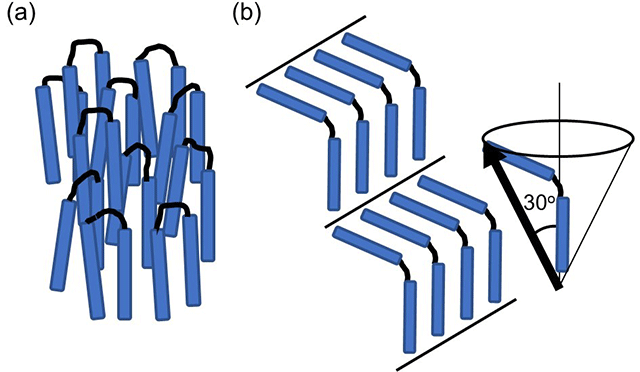
Figure 2. Illustrations of the molecular alignment in the NF (a) and SmAPF (b) phases.
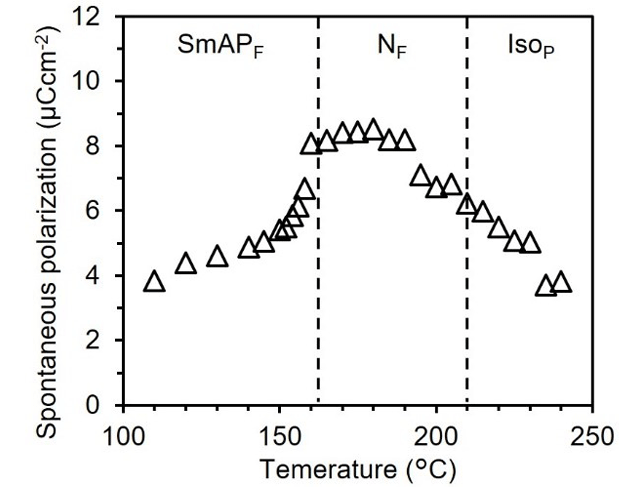
polarization in di-5 (3FM-C4T), measured in a 3 μm-thick
ITO cell.
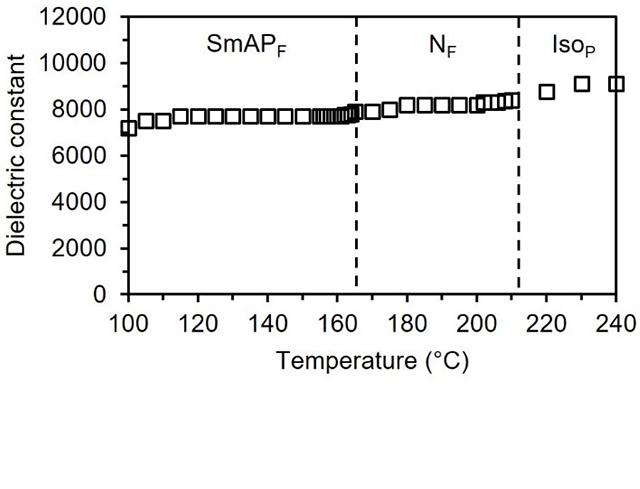
in di-5 (3FM-C4T), measured in a 3 μm-thick ITO cell.
Social Impacts
By applying the newly developed bent-shaped dimeric molecules with huge spontaneous polarization and dielectric constant as a medium, it is possible to realize a variety of high-performance electronic devices. For example, the application to the capacitors will enable miniaturization and low power consumption of electronic devices. Furthermore, the application to the piezoelectric elements and electrostatic actuators will enable low-voltage drive, contributing to improved control technology and energy-saving industrial processes. In the application to 3D video display elements, the technology is promising as an enabling technology for holographic displays because it is less likely to cause crosstalk between pixels in a fine pixel structure and enables high-speed optical switching. Thus, new applications are expected in fields such as automobiles, industrial robots, medical equipment, and video display devices.
Future Prospects
In this research, the three polar phases of the developed bent-shaped dimeric molecules are viscous liquids, and research on immobilization techniques such as elastomerization and gelation is essential for practical applications. With the development of immobilization techniques, the application fields of ferroelectric materials are expected to expand and develop into new application fields.
- Note
This work was supported by LG×JXTG Nippon Oil & Energy Smart Materials & Devices Collaborative Research Programs (April 2019 - March 2021) and LG Material & Life Solution Collaborative Research Clusters (April 2021 -).
| (1) | Publication : | Material Advances |
| Title : | Huge dielectric constants of the ferroelectric smectic-A phase in bent-shaped dimeric molecules | |
| Authors : | Shigemasa Nakasugi, Sungmin Kang, Junji Watanabe, Hiroki Ishizaki, Masato Sone | |
| DOI : |
10.1021/10.1039/D1MA00015B |
| (2) | Publication : | The Journal of Physical Chemistry B |
| Title : | Electric Switching Behaviors and Dielectric Relaxation Properties in Ferroelectric, Antiferroelectric, and Paraelectric Smectic Phases of Bent-Shaped Dimeric Molecules | |
| Authors : | Shigemasa Nakasugi, Sungmin Kang, Tso-Fu Mark Chang, Hiroki Ishizaki, Masato Sone, Junji Watanabe | |
| DOI : |
10.1021/acs.jpcb.2c01938 |
| (3) | Publication : | The Journal of Physical Chemistry B |
| Title : | Spontaneous Polarization Characteristics in Polar Smectic Phases of Fluoro-Substituted Bent-Shaped Dimeric Molecules | |
| Authors: | Shigemasa Nakasugi, Sungmin Kang, Tso-Fu Mark Chang, Takaaki Manaka, Hiroki Ishizaki, Masato Sone, Junji Watanabe | |
| DOI : |
10.1021/acs.jpcb.2c05813 |
- Terms
[1] Spontaneous polarization : Spontaneous polarization is a phenomenon in which a substance polarizes itself without any external influence. This is usually due to molecular structure or molecular symmetry. The charge is spontaneously aligned because of a reduction in the symmetry of the substance.
[2] Ferroelectric liquid crystal : Ferroelectric liquid crystals are liquid crystals that have the property of spontaneous polarity due to a specific phase transition. Conventional liquid crystals change molecular orientation in response to an electric field, and ferroelectric liquid crystals have spontaneous polarity in addition.
[3] Dielectric constant : Dielectric constant is a measure of the ease of polarization (i.e., the amount of electricity that can be stored) and is one criterion for evaluating a material's performance as an insulator.
[4] Chiral molecule : A chiral molecule is a molecule that is nonsuperimposable on its mirror image.
[5] Mesogen : Mesogen is a rigid site that generates the liquid crystal.
[6] Dipole moment : The dipole moment is a vector quantity that expresses the magnitude of the polarization, and is defined as the product of the charge magnitude and the distance. The units are C·m or D (Debye, 1D = 3.33564×10-30 C·m).
- Reference
| Authors : | Shigemasa Nakasugi1,2, Sungmin Kang1,2, Tso-Fu Mark Chang2, Takaaki Manaka3, Hiroki Ishizaki1,2, Masato Sone2, Junji Watanabe2 |
|---|---|
| Title : | Three Distinct Polar Phases, Isotropic, Nematic, and Smectic-A Phases, Formed from a Fluoro-Substituted Dimeric Molecule with Large Dipole Moment |
| Journal : | The Journal of Physical Chemistry B |
| DOI : | doi.org/10.1021/acs.jpcb.3c02259 |
| Affiliations : | 1Advanced Technology Research Department, LG Japan Lab Inc. Japan 2Institute of Innovative Research, Tokyo Institute of Technology, Japan 3Department of Electrical and Electronic Engineering, Tokyo Institute of Technology, Japan |
- Masato Sone | Researcher Finder - Tokyo Tech STAR Search
- Hiroki Ishizaki | Researcher Finder - Tokyo Tech STAR Search
- Sung Min Kang | Researcher Finder - Tokyo Tech STAR Search
- Junji Watanabe | Researcher Finder - Tokyo Tech STAR Search
- Tso-fu Chang | Researcher Finder - Tokyo Tech STAR Search
- Takaaki Manaka | Researcher Finder - Tokyo Tech STAR Search
- Sone / Chang Laboratory (Japanese)
- MANAKA-TAGUCHI LABORATORY
- Electrical and Electronic Engineering Graduate Major|Education|Department of Electrical and Electronic Engineering, School of Engineering
- Electrical and Electronic Engineering Undergraduate Major|Education|Department of Electrical and Electronic Engineering, School of Engineering
- Department of Materials Science and Engineering, School of Materials and Chemical Technology
- Laboratory for Future Interdisciplinary Research of Science and Technology (FIRST)
- Institute of Innovative Research (IIR)
- OPEN INNOVATION PLATFORM
- Office of Research and Innovation
- LG Japan Lab Inc. (Japanese)
- Latest Research News
School of Materials and Chemical Technology
—Encompassing the Disciplines of Science—
Information on School of Materials and Chemical Technology inaugurated in April 2016
School of Engineering
—Creating New Industries and Advancing Civilization—
Information on School of Engineering inaugurated in April 2016
Further Information
Masato Sone, Professor
Institute of Innovative Research, Tokyo Institute of Technology
Email sone.m.aa@m.titech.ac.jp
Tel +81-45-924-5043 / Fax +81-45-924-5044
Hiroki Ishizaki, Professor / Chief Research Engineer
Institute of Innovative Research, Tokyo Institute of Technology / LG Japan Lan Inc.
Email : ishizaki.h.ad@m.titech.ac.jp
Tel +81-45-924-5479



